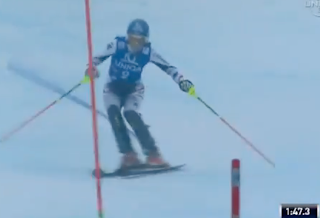Introduction
Since the beginning of it's development, in 1997, my teaching system PMTS, based on world cup racing, and described in my first book, "Anyone can be an Expert Skier", has focused on new techniques. I'm referring to new techniques that have evolved and are used by world cup skiers for the past 17 years or more, but are rarely realized. Every book and video I have produced 8 in total, has developed the focus of inside ski tipping and inside knee flexing. This PMTS movement series with use of the inside of the body, begins at the release of a turn and continues all the way to the end. The Austrians have developed this further in their racers than most other nations.
Hirscher has more emphasis on inside leg flexing and tipping. He really holds his inside foot back. He holds it longer and stronger than the rest. The angle toward downhill, of the inside leg is incredible. You can only achieve this if your focus for the releasing movements are on tipping of your new inside ski, foot, and bending of the inside leg. In other words, get it out of the way.
Ted is more old school, Big toe edge dominant in this engagement.
Two of the best three GS skiers show differences in movements for turn engagement.
Many will say this is no big deal, as with the slip I mentioned in the previous article, no big deal either, however, 1/000 of a second is 2 tenths, in a 2 minute, 30seconds two run GS. Add a slip at the bottom of the arc from squaring up, at the release, and you have 4 tenths in a hurry.

















